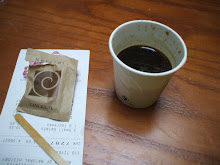This is a story of painful lessons based on poor research.
A few years ago, I was given my great aunt Dorothy's china and silver. The silver included four sets, and it was Oneida Heiress. The china I had once heard referred to as "Dorothy's Spode." Knowing what little I do about antiques, I saw the Oneida as the lesser and the china as the greater—after all, what I knew of Oneida was inexpensive, but nice flatware and Spode was a name that came with a certain cachet.
After lugging these things around for the past few years, I realized that they were adding little to my life beyond weight. Some friends had tried to point this out, but I hadn't listened. I hadn't listened until I took a long hard look at the realities of my life. Fine china had little purpose in my life, and I didn't particularly like the pattern. As for the silver, I'm not a fan of polishing, and until I am, the stuff would just collect dust. Besides, there was at least one other set with more family history attached to it that I knew I'd be inheriting down the line.
This is all a prelude to my decision to include these items and a few decorative plates I'd also been given from Dorothy's various possessions in the alley sale we held on my block today.
I did a fair amount of research to try to get a value on the china. Unfortunately, it did not have any of the marks that Spode—particularly Copeland Spode—should have. The pattern did not match anything I could come up with online. Still, I remember that remark I heard a few times, that it was "Dorothy's Spode." With that, I put a few pieces and a complete inventory out for people to check out. I also put the silver out, though I had done no research on it. My mistake.
The china drew some interest, but no takers. I asked people to make offers; no one did. They said it was nice and moved on to other things. The decorative plates drew some interest, but only one taker. The woman who bought one plate and who fingered the others with interest pointed out to me that two of the decorative plates were transferware, which significantly decreased their worth I discovered on a quick web search later. On further research, it became clear that "Dorothy's Spode" was either a set of seconds or department store-grade version of a pattern—neither the true pattern, nor the provenance to make it truly valuable.
The silver sold quickly. I asked $40 for the set of four place settings and a serving spoon and fork. When the guy offered me $30, I took it. I was tired of the added weight in my life, and tired of worrying about whether I was going to sell anything at the alley sale. Oh, but isn't short-term gain a long-term loss sometimes. After doing a bit of further research on the china this evening, I decided to check replacements.com for a value on the silver. What I found was that I had given the guy a killer deal—$30 for a set that could sell for nearly two hundred. Granted: selling it for that would require time and patience for polishing, both of which are in short supply.
Still, it's a little bittersweet to discover that I relied on vague memories of family history rather than doing my own investigation. Next time, maybe I'll give a little more respect to the dead and take a little more time to do research. Or perhaps I'll simply take the path I've chosen with the china—Banana likes it, so we'll hang on to it for the time-being.
After all, to quote Wendell Berry: "Short-term practicality is long-term idiocy." I think I'm going to aim for long-term sensibility.
skip to main |
skip to sidebar

I'm back. Have a blast, y'all.

About Me
Blog Archive
- June (1)
- July (1)
- May (5)
- January (3)
- December (1)
- November (2)
- September (4)
- August (11)
- July (7)
- June (1)
- May (2)
- April (2)
- March (5)
- February (4)
- January (4)
- November (3)
- October (3)
- September (3)
- August (1)
- July (3)
- April (2)
- March (5)
- February (3)
- January (7)
- December (8)
- November (12)
- October (5)
- September (8)
- August (6)
- July (5)
- June (14)
- May (13)
- April (24)
- March (21)
- February (22)
- January (22)
- December (20)
- November (26)
- October (24)
- September (35)
- August (27)
- July (36)
- June (21)
- May (26)
- April (28)
- March (27)
- February (20)
- January (38)
- December (26)
- November (11)
- October (32)
- September (33)
- August (30)
- July (36)
- June (34)
- May (50)
- April (36)
- March (3)
- January (3)
- December (3)
- November (3)
- August (6)
- July (4)
What I Like
- A List Apart
- Accidental Creative
- AdLand
- AdRants
- Atrios
- Batocchio
- Byrd House Market
- Chowhound
- Creating Passionate Users
- daddytypes.com
- Daily Kos
- Design Observer
- design*sponge
- Epicuriousity (John Haddad)
- Flickr shots
- Gawker
- Getting Real - 37 Signals
- Gothamist
- Incertus
- Phil's bookmarks (web design and more)
- river city food and wine
- Smeltery fonts
- TreeHugger
- Veer
- Vitaly Friedman's fonts
- Wonkette
- Wornamental, Thornamental Design
- Xtcian
- zefrank
